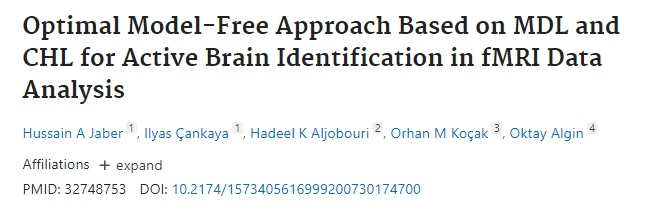Hussain A Jaber, Ilyas Çankaya, Hadeel K Aljobouri, Orhan M Koçak and Oktay Algin have published a new article titled ”Optimal Model-Free Approach Based on MDL and CHL for Active Brain Identification in fMRI Data Analysis”.
Abstract
Background: Cluster analysis is a robust tool for exploring the underlining structures in data and grouping them with similar objects. In the researches of functional magnetic resonance imaging (fMRI), clustering approaches attempt to classify voxels depending on their time-course signals into a similar hemodynamic response over time.
Objective: In this work, a novel unsupervised learning approach is proposed that relies on using Enhanced Neural Gas (ENG) algorithm in fMRI data for comparison with Neural Gas (NG) method, which has yet to be utilized for that aim. The ENG algorithm depends on the network structure of the NG and concentrates on an efficacious prototype-based clustering approach.
Methods: The comparison outcomes on real auditory fMRI data show that ENG outperforms the NG and statistical parametric mapping (SPM) methods due to its insensitivity to the ordering of input data sequence, various initializations for selecting a set of neurons, and the existence of extreme values (outliers). The findings also prove its capability to discover the exact and real values of a cluster number effectively.
Results: Four validation indices are applied to evaluate the performance of the proposed ENG method with fMRI and compare it with a clustering approach (NG algorithm) and model-based data analysis (SPM). These validation indices include the Jaccard Coefficient (JC), Receiver Operating Characteristic (ROC), Minimum Description Length (MDL) value, and Minimum Square Error (MSE).
Conclusion: The ENG technique can tackle all shortcomings of NG application with fMRI data, identify the active area of the human brain effectively, and determine the locations of the cluster center based on the MDL value during the process of network learning.
Keywords: Enhanced Neural Gas (ENG); fMRI Clustering Technique; Minimum Description Length (MDL); Neural Gas (NG); Prototype-based Clustering (PBC).
